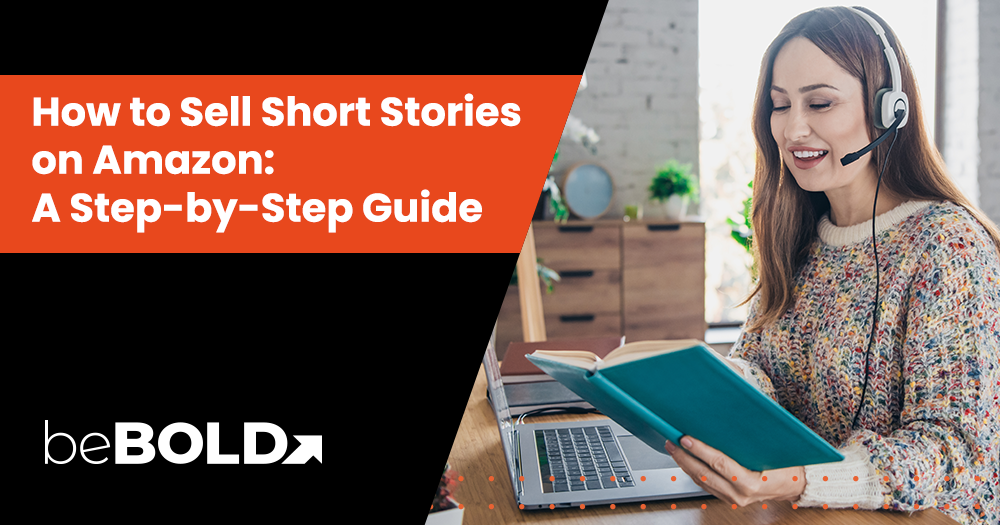Key Highlights
- Amazon’s self-publishing platform gives authors immediate access to a massive audience without delays or gatekeepers.
- Hook readers from the start, keep the plot tight, and end with impact. Professional editing is key.
- Price short stories between $0.99 and $2.99 for visibility and higher royalties.
- Bundle stories or offer one as a free download to build your email list and boost sales.
- Ensure you hold the copyright for your work, use royalty-free images for covers, and follow Amazon’s guidelines to avoid violations and protect your revenue streams.
- Upload your short story to Amazon KDP, set your price, and publish. Your story can be live and earning in 24-72 hours.
- beBOLD Digital helps authors create tailored strategies to maximize sales, grow readership, and elevate their brand.
Amazon has become a goldmine for writers, and short story authors are finally getting their moment. With digital content on the rise, bite-sized fiction is booming, perfect for today’s fast-paced world where readers crave quick, satisfying reads on the go. Kindle’s mobile-friendly format makes short stories easy to access anytime, anywhere, turning them into a powerful tool for earning revenue and growing your author brand. When packaged and marketed right, they can build loyal audiences and generate consistent income. In this step-by-step guide, you’ll learn how to sell short stories on Amazon and transform your creativity into a thriving publishing venture.
Identifying the Reader Demographics for Short Stories

Short stories on Amazon attract a diverse range of readers, but certain genres tend to perform exceptionally well in shorter formats. Here are some genres that deliver impact quickly and keep readers coming back for more:
- Romance: Readers love the instant emotional connection and satisfying resolution without a long wait.
- Thrillers & Mysteries: Short formats heighten suspense and deliver twists fast, keeping readers hooked.
- Science Fiction: Allows for imaginative concepts and high-stakes ideas in quick, digestible bursts.
- Fantasy: Mini adventures and magical moments feel complete without needing an epic saga.
- Horror: The short length amplifies tension and fear, delivering a punchy scare.
- Literary Fiction: Sharp character insights and emotional depth fit well into compact storytelling.
- Young Adult (YA): Relatable themes and fast-paced plots resonate strongly in shorter reads.
- Comedy & Satire: Quick wit and humour land better when delivered in small, focused doses.
Also Read: How To Create a Planner to Sell on Amazon and Profit?
Crafting Your Short Story for Amazon

Before you can sell your short story, it needs to be reader-ready. That doesn’t mean spending months perfecting every sentence, but it does mean ensuring your story is sharp, engaging, and marketable.
In this section, we’ll quickly walk through the essentials: story structure, character development, plot, editing, and the all-important book cover design. These steps will help you stand out in a crowded marketplace. Let's dive in.
1. Elements Critical to a Successful Short Story
To captivate readers, a short story must have a strong hook from the very beginning, immediately drawing them into the world you've created. Focus on:
- A gripping opening line that pulls the reader in immediately.
- Tight structure with zero fluff, every sentence should push the story forward.
- Emotional impact that lingers, even in a short read.
When your story grips readers from the start and delivers a powerful punch, it’s far more likely to earn 5-star reviews, shares, and repeat sales.
2. Character Development in Brevity
In a short story, you have limited space to develop your characters. Stick to:
- One or two main characters that readers can quickly connect with.
- Use dialogue and small actions to reveal personality fast.
- Give your protagonist a clear goal or conflict early on.
Well-crafted characters drive emotional connection, and connected readers are more likely to finish your story, leave reviews, and buy your future titles.
3. Constructing a Compelling Plot
Crafting a compelling plot in a short story means sticking to a clear narrative arc. Aim for:
- A clear beginning, middle, and end; no detours.
- Immediate tension or conflict to keep pages turning.
- The ending of the story should feel natural and satisfying, not sudden or forced.
A tight, engaging plot keeps readers hooked till the end, boosting completion rates, positive reviews, and word-of-mouth sales.
4. Editing and Perfecting Your Story
Editing is where the magic happens. After your first draft, make sure to:
- Do multiple self-edits, focusing on clarity and pacing.
- Use tools like Grammarly or ProWritingAid for grammar checks.
- If budget allows, hire a professional editor; it’s worth it.
Polished writing builds credibility, earns better reviews, and increases the chances of your short story converting browsers into buyers.
5. Designing an Attractive Book Cover
A compelling cover is essential to attract clicks and sales. So, make it count.
- It should be genre-appropriate and look good as a thumbnail.
- Use tools like Canva, BookBrush to create a cover that stands out and conveys the essence of your story.
- If you’re not a designer, consider hiring a professional freelance designer.
Your cover is your first impression, if it doesn’t grab attention, your story won’t get the chance to sell.
Done writing your story? Now learn how to self-publish it on Amazon and start earning.
Listing and Selling Your Short Stories on Amazon

Writing your story is only half the journey; selling it is where the real opportunity lies. Amazon makes it easy for authors to publish and profit, but standing out takes more than just hitting “upload.” So, let's uncover the exact steps to publish your short story through Amazon KDP, how to price it right, and the marketing strategies that actually drive sales.
Step-by-Step Process for Publishing on Amazon KDP
Publishing short stories as ebooks on Amazon is a great way to create passive income on a regular basis with less time investment than full-length novels. Follow these steps to get your short book live and ready to sell:
1. Sign in to Amazon KDP: Go to kdp.amazon.com and log in with your Amazon account.








Pricing Strategies for Maximum Profit
When pricing short stories, most authors set their prices between $0.99 and $2.99 to maximize visibility and sales. This range offers a good balance between affordability and royalty rates.
Here’s how to price smart:
- Start at $0.99 to attract first-time readers and gather reviews.
- Test different price points to see what maximizes sales vs. royalties.
- Consider using $2.99 for bundles or high-value stories for 70% royalty in most regions.
- Use limited-time discounts to boost visibility and rankings.
Marketing Techniques to Increase Visibility

To attract readers and generate sales, you’ll need smart, consistent marketing. Here are key techniques to boost your story’s visibility on Amazon and beyond:
- Amazon Keywords: Choose effective keywords that potential readers are likely to search for. These should reflect your genre and themes to ensure your story appears in relevant searches.
- Categories: Select the right categories for your story to increase its discoverability in niche markets. Being placed in the right category can help you rank higher on Amazon.
- Email Lists & Social Media: Build an email list and leverage social media platforms to spread the word about your story. Use engaging posts to tease your plot and encourage readers to buy.
- Kindle Unlimited: Enroll your short story in Kindle Unlimited (KU), Amazon's subscription service. KU allows readers to access your story for free while you earn royalties based on pages read. It’s a great way to increase exposure.
New to Amazon? Learn the basics with our Step-by-Step Guide on How to List Products on Amazon.
Beyond Individual Sales: Other Ways to Monetize Your Short Stories

Selling single short stories is just the starting point; there’s a lot more you can do to boost income and grow your readership. Smart authors repurpose and repackage their content to create new revenue streams and long-term engagement. Let’s look at two powerful strategies:
Bundling Stories into Collections
Bundling multiple short stories into one collection is a smart way to increase perceived value and generate higher earnings. When readers purchase a collection, they feel like they’re getting more for their money, which can encourage larger sales.
Collections also provide an opportunity to introduce new readers to your work. By offering a mix of stories, you can attract a broader audience and create a sense of excitement around your brand, all while maximizing your earning potential.
Looking for a simple product that can generate consistent passive income? Get design tips, formatting rules, and launch strategies inside How to Create a Journal to Sell on Amazon.
Utilizing Short Stories as Lead Magnets
Offering a short story as a free download can be an effective way to grow your email list. As a lead magnet, a free story can capture the attention of potential readers and funnel them toward future purchases.
Once you’ve gained their interest, you can nurture these readers through email marketing, directing them to your other books, collections, or upcoming releases. This approach not only builds your audience but also creates long-term relationships that lead to increased sales down the line.
Your Short Story Deserves a Bigger Audience, Let beBOLD Digital Help You Find It
Want your short stories to actually sell on Amazon, not just sit there? At beBOLD Digital, we help authors like you turn passion projects into profitable digital assets.
From optimizing your Amazon listings with the right keywords and categories to crafting sales-focused descriptions and implementing proven marketing strategies, we handle it all so you can focus on writing. Whether you’re just starting out or looking to scale, our tailored approach helps you reach more readers and grow your author brand with confidence.
Ready to take your stories to the next level? Book your free consultation with beBOLD Digital today.
Conclusion
Selling short stories on Amazon is no longer just a niche opportunity; it’s a viable path for writers to build a brand, reach global audiences, and earn meaningful income. With the right approach, even a single well-crafted short story can spark visibility and create loyal readers. From refining your content and packaging it professionally to navigating Amazon KDP and mastering discoverability through keywords and categories, every step plays a role in your success.
And remember, the process doesn’t end after you hit “publish.” Consistent marketing, creative monetization strategies, and thoughtful reader engagement will keep your stories moving and selling. Whether you're starting with one story or planning a whole collection, you now have the roadmap to turn your writing into a powerful digital asset. Keep writing and keep publishing.
Selling short stories on Amazon is more than a niche—it’s a real opportunity to build your brand, reach global readers, and earn passive income. With the right keywords, categories, and compelling product pages, even a single story can gain traction and spark loyal readership. But success doesn’t stop at hitting “publish.” Ongoing marketing, audience engagement, and smart monetization strategies are key to keeping your stories visible and selling.
That’s where beBOLD Digital comes in. We help authors turn their passion projects into profitable digital assets through listing optimization, strategic positioning, and tailored marketing support. Whether you're just starting out or looking to scale, we’ll help you reach more readers and grow with confidence. Ready to take your stories to the next level? Book your free consultation today.
Frequently Asked Questions
How long should a short story be for Amazon?
Amazon accepts short stories as short as 2,500–5,000 words, but the most effective stories typically range from 3,000–7,500 words. This length is ideal for creating compelling narratives while maintaining reader engagement, boosting regular income streams.
Can I publish a short story as part of a collection?
Yes, publishing short stories as part of a collection is a great way to boost earnings. Bundling multiple stories into one package increases value, encourages repeat purchases, and allows you to repurpose existing content for continuous income.
What are the best genres for short stories on Amazon?
Popular and profitable genres for short stories on Amazon include romance, horror, sci-fi, fantasy, and mystery. These genres tend to perform well in short form, attracting regular readers and creating steady income streams through repeat purchases.
Are there specific legal considerations when publishing on Amazon?
When publishing on Amazon, ensure you own the copyright to your content, use royalty-free images for covers, and avoid plagiarism. Adhering to KDP’s terms of service is crucial for avoiding violations and ensuring long-term success in your income streams.
Want to take your short stories to the next level? Contact beBOLD Digital for expert marketing solutions that drive results on Amazon.











Comments